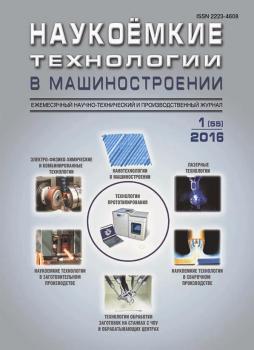Simferopol, Russian Federation
Simferopol, Russian Federation
Simferopol, Russian Federation
The interaction analysis of abrasive grain tip contact probability with the material, number, the form and length of single cuts at finishing processes of flat grinding is presented. It is shown that when passing a contact area of a blank with a disk a grain can cut material off, if it falls on one of protrusions of surface roughness, or will not cut it, if it falls on one of roughness cavities. The dependencies obtained in the work allow estimating the influence of a grinding mode and tool characteristics on the length of single cuts, defining basic parameters of a grinding process, watching regularities in the formation of micro-relief formation on the surface worked and forming its rated profile which can be obtained at the operation fulfillment. The example of the computation and formation of a theoretical profile of a surface micro-relief is shown.
grinding, abrasive grain, tool and blank interaction, material removal probability, grinding process parameters.
1. Modern competitive technologies in abrasive-diamond processing of blanks / Yu.М. Zubarev, Z.I. Kremen, Yu.М. Yermakov, Yu.S. Stepanov // Reference Book. Engineering Journal". - Edition №5. - Moscow. - 2011. - pp. 39-42.
2. Novoselov Y. Calculation of surface roughness parameters for external cylindrical grinding / Y. Novoselov, S. Bratan, V. Bogutski, Y. Gutsalenko // Journal Fiability & Durability Supplement no 1/ 2013, Editura “Academica Brâncuşi” , Târgu Jiu, Р. 5-15.
3. Novosyolov, Yu.К., Bratan, S.М. Simulation of interaction processes of grinding disk and blank at finishing grinding // Bulletin of SevNTU: Proceedings of Series:Mechanical and Instrument Engineering and Transport. Edition118. - Sevastopol: Publishing House of SevNTU, 2011. - pp. 92-106.
4. Novosyolov, Yu.К., Bogutsky, V.B. Abrasive grain wear in disk when blank grinding // Bulletin of SevNTU: Proceedings. Series: Mechanical and Instrument Engineering and Transport. Edition 129. - Sevastopol: Publishing House of SevNTY, 2012. - pp. 23-29.
5. Zhen Bing Hou. On the mechanics of the grinding process - Part I. Stochastic nature of the grinding process / Zhen Bing Hou, Ranga Komanduri // International Journal of Machine Tools & Manufacture 43, 2003, рр. 1579-1593.
6. C. Aurich Modeling and simulation of process: machine interaction in grinding/ C. Aurich, D. Biermann, H. Blum et al. // Production Engineering, vol. 3, no. 1, 2009, pp. 111-120.
7. Hassan Abdel-Gawad El-Hofy. Fundamentals of Machining Processes: Conventional and Nonconventional Processes, Publisher: CRC Press, 2006, - 562 р.
8. Rogelio L. Hecker. Predictive modeling of surface roughness in grinding./ Rogelio L. Hecker, Steven Y. Liang // International Journal of Machine Tools and Manufacture Vol. 43, Issue 8, June 2003, P.755-761.
9. W. Brian Rowe. Principles of modern grinding technology. -Jordan Hill, Oxford ОХ2 8DP: UK 2009. - 421 р.
10. Novosyolov, Yu.К. Surface Shaping Dynamics During Abrasive Processing. - Publishing House: LAP LAMBERT Academic Publishing, 2017. - pp. 317.
11. Bratan, S.М. Technological Fundamentals for Assurance of Quality and Stability Increase in Efficient Finishing and Fine Grinding. Thesis for D.Eng. Degree: 05.02.08. − Sevastopol, 2006. - pp. 339.















